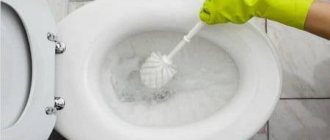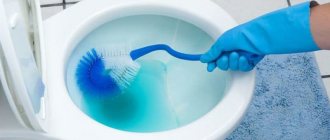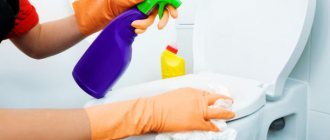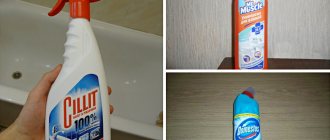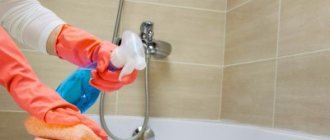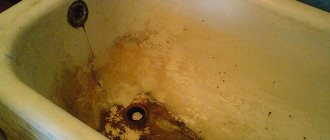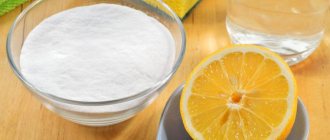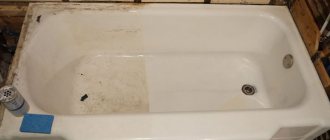Potassium permanganate stains from the surface of bathtubs are difficult to remove. Colored traces may remain after taking a pink medicinal bath, which is prepared from small crystals of potassium permanganate. Conventional soap products are ineffective against such contaminants. In such cases, store-bought and improvised devices will come to the rescue, the practice and experience of which have proven their effectiveness.
General rules
What do you need to deal with stains on the walls of the bathtub?
- Clean immediately after draining the solution - the shorter the exposure time, the easier it is to clean.
- Have a few homemade and store-bought products in stock so you don’t have to look for something to clean your bathtub with.
- Do not allow splashes to get on the seams of the tiles - they will be more difficult to clean than a smooth surface.
It is important to consider the material from which the bathtub is made. Acrylics are the most capricious and require gentle cleaning.
Chemical acids for removing potassium permanganate stains
Potassium permanganate is known to everyone not only for its antiseptic properties, but also for its coloring properties. Its molecules form corrosive stains on clothing and furniture. This problem is well known to doctors and chemists, who can get their coats dirty while working.
You may not be able to get rid of them when using laundry detergent or bleach. And then you will need to solve the problem: how to remove potassium permanganate from your favorite thing.
It’s good that the methods for getting rid of stains are simple and accessible; in most cases, the necessary substances are found in every housewife’s medicine cabinet or refrigerator.
Since potassium permanganate is a chemical substance, acids can fight it. But before working with acids, you need to take care of your hands by protecting them with rubber gloves. If substances do get on the skin of your hands, you should wash your hands with plenty of water and soap.
Color characteristic of potassium permanganate
How to clean a bathtub?
Plaque on the walls can be erased in several different ways. Abrasive agents are used only for cast iron or enamel bathtubs; acrylic bathtubs are cleaned with liquid compounds. To wash off potassium permanganate from the bath, you need to prepare everything you need in advance. Fresh marks are easier to wipe off.
What will help wash off potassium permanganate?
- Vinegar 9% or higher concentration.
- Hydrogen peroxide.
- Soda.
- Ready-made cleaning compositions: cream, powder or paste.
- Bleach: oxygen or chlorine.
For washing you will need rubber gloves and a sponge. A mask may be required because some products have a strong odor.
What is needed to remove contaminants?
In this article we will figure out how to clean a bathtub from potassium permanganate with commonly available means. At least one of them should be in your home. In terms of tools, all you need is a sponge or rag, a small container, and gloves. The latter are necessary, since many of the products used negatively affect the condition of the skin.
Important! Always use gloves when working with potassium permanganate. Potassium permanganate tends to be absorbed into the skin, which leads to a light tanning effect.
Here's what we can use to clean the bathtub:
- Baking soda;
- Table vinegar;
- Citric acid;
- Chlorine-based bleach;
- Concentrated stain remover (oxygen);
- Hydrogen peroxide;
- Cleaning products, for example, Domestos;
- Acrylic surface restoration kit.
Vinegar and peroxide
After the water with the permanganate solution has been drained, you can begin cleaning. It is necessary to open the door for ventilation, since when cleaning with vinegar, concentrated vapors can cause burns to the respiratory tract.
Next you should proceed like this:
- Rinse the bath with water and wipe, removing any remaining potassium permanganate.
- Apply acetic acid to a sponge and rub.
- Rinse the walls thoroughly.
- If necessary, repeat processing.
We recommend: How to remove a blockage in the bathroom at home?
When washing with vinegar, be sure to wear gloves and a mask, and the door to the bathroom must be open.
Removing marks from the skin
What to do if stains from potassium permanganate appear on the skin? What should I use to clean them? Don’t worry too much, because there are several ways to deal with this.
Hydrogen peroxide and acetic acid
You can remove pink marks using a combination of two components. Take hydrogen peroxide and vinegar and mix in the same ratio. Add the same amount of water. Wash your hands with the resulting solution. Residues should be removed under running warm water.
Medical alcohol
There is another good way to remove contaminants. Regular medical alcohol will help with this. Soak a cotton pad in the liquid and treat the stained areas. To get rid of the smell, wash your hands with laundry soap.
Lemon juice
If you don’t have the above ingredients on hand, lemon juice will come to the rescue. Cut the fruit into several slices. Squeeze out the juice and then mix with water. Apply the resulting solution to your hands and wash with soap.
Abrasives
You can wash off potassium permanganate from a cast iron or enamel bath with soda or store-bought cleaning compounds - powder, cream, and pastes. For this you need a sponge with a hard side and gloves. The method is more labor-intensive and time-consuming than using vinegar or peroxide, since to wash the walls you will have to put in some effort and scrub thoroughly.
Why is potassium permanganate so difficult to wipe off?
Medical manganese is sold in the form of crystalline powder in plastic or glass vials. The substance appears dark, almost black.
For use, potassium permanganate is diluted in ordinary water. When it comes into contact with liquid, it turns it pink. The thickness of the color depends on the dosage of the powder. To get a glass of bright pink water, just dissolve the crystals in it on the tip of a knife. Potassium permanganate has this color due to its unique chemical composition.
Interacting with oxygen, potassium permanganate oxidizes and turns brown. As stains of the substance dry, they become persistent and are difficult to remove from surfaces. This is again due to the special properties of potassium permanganate, its ability to penetrate deep into tissue and crystallize upon contact with air.
The thicker the solution of potassium permanganate, the more difficult it is to wipe it off.
"Whiteness" and oxygen bleach
On the Internet you can find another method of cleansing - soaking. Draw a bath, fill it with a solution of chlorine or oxygen bleach overnight, and wash it in the morning.
The method is unlikely to be suitable for everyday use. Its disadvantages:
- duration;
- high water consumption;
- inhalation of chlorine fumes is harmful to health;
- There is a risk that children and pets will get to the cleaning solution.
However, if the walls of the bathtub are covered with stubborn plaque that could not be removed otherwise, soaking with a concentrated solution can whiten the surface. When using this method, it is important to ensure safety - ventilation, thorough rinsing after draining. Be sure to limit access to the bathroom for children and pets.
Removing stains from linoleum
How to clean dirt from linoleum? Experienced housewives claim that if potassium permanganate has not corroded the coating, then you can wash off the stain with bleach or citric acid.
To do this, you need to take a bucket, pour 3-5 liters of water into it, and pour in a bag of lemon powder. Mix thoroughly and treat the stained areas several times. Whiteness can generally be poured directly onto the dirt itself.
Some people say, “I clean marks with rubbing alcohol.” But before you start working, test the reaction in an inconspicuous area. If nothing happens, then continue the procedure.
If you cannot solve the problem on your own, then it is better to wash the linoleum in a sink. Specialists will select the right chemicals and carefully remove the stain.
Baby bath - special care
If your baby will be bathing in potassium permanganate, it is better to buy a small plastic or enamel bath. The consumption of water and permanganate is less, and washing a small bath after treatment procedures is faster and easier.
It is preferable to choose a light color - dirt is immediately visible on such products.
It is better to clean a baby’s bath with home remedies – vinegar or soda. Be sure to rinse well after washing.
Why are potassium permanganate stains so persistent?
Potassium permanganate is a proven disinfectant. The brightness of its spots is determined by the chemical composition of the substance. It strongly eats into skin, fabric and various surfaces. After just a couple of minutes, the traces oxidize in air and turn brown. Simply washing them off with soapy water will not work. More effective methods are needed.
Potassium permanganate pigments are very durable
To help housewives
In order not to spoil the bathtub, and also not to waste extra time and effort on cleaning, you must follow several rules:
- Permanganate must be dissolved in a separate container so that small crystals do not get into cracks or surface irregularities. Otherwise, they will cause staining that will be difficult to remove.
- In the treatment of fungal and genitourinary diseases, the pelvis can be used.
- It is necessary to drain the solution from a basin or baby bath gradually, without splashing, so that you do not have to wash two containers.
- It is important to follow safety precautions and not mix detergents: a chemical reaction with the release of vapors can cause burns, eye and respiratory tract irritation.
- Be sure to use gloves, a mask, and wash in a ventilated area.
- Abrasive and highly concentrated products are only permissible for cast iron, enameled bathtubs. Acrylic surfaces should not be rubbed with powder or a stiff brush, even if other means have not helped: this will hopelessly damage the material.
- Household chemicals should be stored out of the reach of children and hidden immediately after cleaning.
We recommend: How to reduce water consumption in the toilet?
If, as a result of treatment procedures with potassium permanganate, the acrylic surface is damaged and it is impossible to wash it, you will have to buy a kit for repairing such products - it will restore the whiteness and also extend the service life of the bathtub.
Baths with potassium permanganate
Taking baths with the addition of potassium permanganate is an effective medical procedure that is used mainly for children. It is used in the presence of certain skin diseases and wounds on the body. Such baths are also used by adults in similar cases, as well as in the treatment and prevention of hemorrhoids.
Children are bathed in special small baths, but adults take regular baths with the addition of potassium permanganate. Regardless of the volume of the container, a characteristic coating quickly forms on its surface. After 2-3 sessions, the plaque becomes stable. We advise you not to let it get to this point, but to take action quickly. A dirty bath or tub is, at a minimum, unhygienic, which calls into question the medical meaning of the procedures.
Are you happy with the cleanliness of your bath?
Not really
Stains on clothes
When potassium permanganate gets on clothing, noticeable marks remain. To remove them, you can use one of the following methods:
- squeeze the juice out of a lemon, pour it onto the stain, rub and leave for 10-15 minutes, then wash the stained item as usual;
- soak the part of the clothing where the stain is located in a basin with kefir or yogurt for 5-6 hours, then wash as usual;
- apply a paste of soda to the stained area, rub, leave for several hours, after which wash this item of clothing - this method is suitable for white things;
- mix hydrogen peroxide with citric acid, apply to the contaminated surface, then rinse - this is best used for light-colored fabrics.
Preparatory stage
The appearance of a brown or red spot on the skin indicates not only its coloring, but also a burn that occurs as a result of contact with permanganic acid. If the concentration of the substance was small, then it simply penetrates the skin through the pores and stains it. If a manganese crystal that has not dissolved in water gets on the skin, it can cause a burn.
To effectively remove stains, it is necessary to prepare the skin so that the stain can be washed away quickly without damaging the skin. At the initial stage, the skin is thoroughly washed with a soap solution until the water stops turning pink. Then, using a hard sponge or other abrasive, remove the keratinized top layer of skin as a result of a burn or staining. You must act carefully so as not to damage the integrity of the skin. At the final stage, you can begin to eliminate stains.
You can wash potassium permanganate off your skin using ordinary running tap water. However, this process is lengthy and takes at least two days. For lack of time, use the following available methods:
